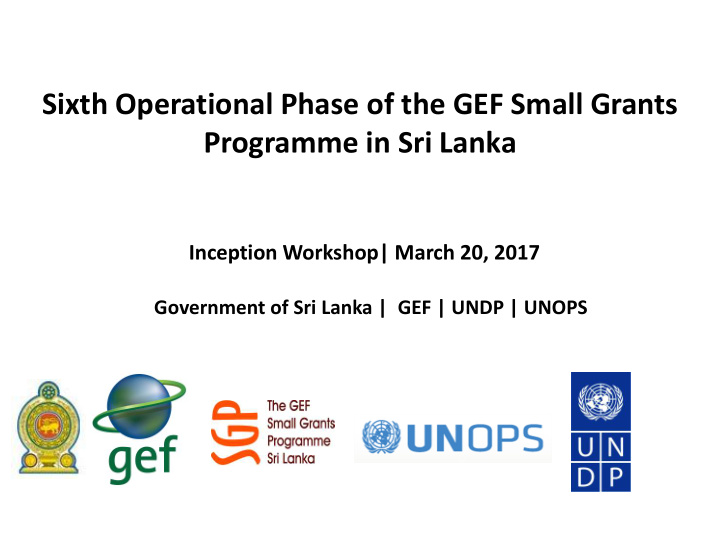



Sixth Operational Phase of the GEF Small Grants Programme in Sri Lanka Inception Workshop| March 20, 2017 Government of Sri Lanka | GEF | UNDP | UNOPS
Background Established in 1994 Total grant amount received – US$ 8,632,909 Total number of projects 396 Total number of projects in OP V -62: total amount granted US$ 2,150,000 Duration of OP V 2011-2015 Main Focal Areas Bio Diversity Climate Change Land Degradation Chemicals International Waters
Summary of projects 1994-2015
Sixth Operational Phase of the GEF Small Grants Programme in Sri Lanka 2017-2020 Main Outcome Policies, programmes and capacities to ensure environmental sustainability, address climate change mitigation and adaptation, and to reduce disaster risks in place at national, sub- national and community levels
Project Overview Objective : To enable community organizations to take collective action for adaptive landscape management for socio-ecological resilience through design, implementation, and evaluation of grant projects for global environmental benefits and sustainable development. Project locations are three ecologically sensitive landscapes: the Knuckles Conservation Forest and its buffer zone, the coastal region from Mannar Island to Jaffna, and the Urban Wetlands of Colombo. Assist CSOs/CBOs to implement projects that will generate ecological, social and economic synergies: and projects that will produce greater and potentially longer lasting global environmental benefits Take experiences, lessons learned and best practices from prior initiatives to scale-up during this projects lifetime
OP6 Project formulation process: Country-led and informed by extensive consultations Priorities based on government vision for development and addressing Bio Diversity, Climate Change and Land Degradation concerns of the three conventions UNCBD, UNFCCC, UNCCD. National Steering Committee (NSC) and Technical Advisory Group (TAG) guided project design and development over a 2 yr period Extensive consultations with government, and allocation approval similar to the former phases GEF 3, GEF 4, GEF 5 Wide consultations with Civil Society organizations and communities in the field through meetings and workshops Initial project concept endorsed by NSC and approved by UNDP GEF to proceed with proposal development 2 local and 1 international Consultant/s involved in the formulation of the full proposal
Project Formulation Process contd. • Project Launch and validation – Full participation of the Government (Director Global Affairs, former Secretary MoERE in the two day project launch workshop) • NSC selection of landscape areas and full participation at project launching and validation workshops • Participation of Local Government at meetings and discussions • Participation of CSOs (NGOs and CBOs) at project launching workshop, meetings and discussions at field level and local government meetings • Participation of communities in selected villages in the three landscapes
The Proposed Process An example of possible outcomes
The 3 Landscapes covered by the project Landscape 1 Knuckles Conservation Forest and the buffer zone Coverage : Districts of Matale and Kandy DS Divisions in Matale: Laggala- Pallegama, Rattota, Ukuwela, Panwila DS Divisions in Kandy: Patha Dumbara, Meda Dumbara, Uda Dumbara, Minipe
The 3 Landscapes covered by the project contd Landscape 2 Urban Wetlands of Colombo Coverage : District of Colombo DS Divisions: Kaduwela, Homagama, Maharagama, Kolonnawa, Kotte
The 3 Landscapes covered by the project contd Landscape 3 Coastal area from Mannar island up to Jaffna Coverage : Districts of Mannar & Kilinochchi DS Divisions in Mannar: Mannar, Manthai West, Musali, Nanaddan DS Divisions in Kilinochchi : Poonakary
Targeted geographies and beneficiaries Selection of landscapes based on: Continuous decline in biological diversity, increasing threats to flora and fauna & human/animal conflicts, encroachments of sensitive eco-systems and habitats; land fragmentation, ad-hoc development efforts, increase in poverty of vulnerable communities & migration of younger generation; Vulnerability to CC; increasing variability in weather patterns affecting agriculture, water scarcities both potable and for irrigation, increase in invasive species, increasing exposure of farmers and communities to climate inconsistencies; Poverty incidence, soil and water pollution, land degradation issues, lack of livelihood opportunities especially for women, lack of proper market facility for products.
Targeted geographies and beneficiaries Targeted beneficiaries based on vulnerability criteria including: Farmer/fishing communities Women headed households/young unemployed women Youth who can be oriented towards environment conservation and related livelihoods Households with disabilities Conflict displaced/resettled communities Capacity building of stakeholders in all levels of administrative network set up
Implementation Arrangements & Organizational Structure Additional Project support – Technical Advisory Group (TAG); District and Divisional Secrataries and other Local Government Authorities, NGOs, CBOs
Project Financing Financing Plan GEF Trust Fund USD 2,497,078 UNDP TRAC resources USD 100,000 (1) Total Budget administered by UNDP USD 2,597,078 Parallel co-financing ( all other co-financing that is not cash co-financing administered by UNDP) UNDP USD 400,000 (in kind) Government USD 700,000 (in kind) Sri Lanka Nature Forum, Chair of SGP National USD 1,100,000 (in cash) Steering Committee Sri Lanka Nature Forum, Chair of SGP National USD 1,000,000 (in kind) Steering Committee (1) Total co-financing USD 3,200,000 (1) Grand-Total Project Financing (1)+(2) USD 5,797,078
Thank you!!!
Recommend
More recommend